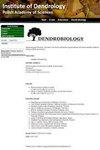Effect of seedling production method on the growth of Pinus sylvestris L. on reclaimed post-industrial sites in Poland
IF 1.8
4区 农林科学
Q2 FORESTRY
引用次数: 1
Abstract
Selection of tree species and proper technology of afforestation of post-industrial sites play a crucial role in new ecosystem stability and success of the restoration. There is still current discussion about the effectiveness of different methods in the production of seedlings for extreme site conditions. This study aimed to analyze the effect of the seedling production method on the growth of 6-year-old Scots pine (Pinus sylvestris L.) trees planted on reclaimed post-industrial sites in southern Poland. We compared four methods of seedling production: bare root system, containerized without and with inoculation of ectomycorrhizal fungi Laccaria bicolor (Maire) P.D. Orton, and Hebeloma crustuliniforme (Bull.) Quél. The experiment was carried out independently on two reclaimed sites: a post-sand-mining site in Bukowno, and a heavy metal polluted site in Miasteczko Śląskie. The effect of the seedling production method on tree growth expressed by height, root collar diameter, above- and belowground biomass of different tree components was analyzed on 240 sampled trees using analysis of variance and general linear model. In addition, the effect of the seedling production method on the root-to-shoot ratio was investigated. Scots pine tree growth was significantly affected by the seedling production method on heavy metal polluted site. The lowest tree growth parameters were observed in trees planted with bare roots, whereas the largest values were in the case of trees planted from containerized seedlings inoculated with H. crustuliniforme. In contrast, on the post-sand-mining site, the treatment effect turned out to be insignificant. The effect on biomass allocation was observed in the case of both sites. Trees prepared with the bare root method differed in greater biomass allocation to the belowground from other treatment groups. The use of containerized seedlings or additionally inoculated with ectomycorrhizal fungi in heavy metal contaminated sites improves the growth of trees and, although it is more costly and labor-intensive compared to the production of seedlings with a bare root system, should be preferred. In the post-sand-mining area, no effect of the seedling production method on tree growth was observed, and the use of bare root seedlings will be equally effective and additionally less time and cost-consuming.波兰开垦后工业用地上苗木生产方法对樟子松生长的影响
后工业立地的树种选择和造林技术对新生态系统的稳定和恢复的成功起着至关重要的作用。目前仍有关于不同方法在极端场地条件下生产幼苗的有效性的讨论。本研究旨在分析育苗方法对波兰南部后工业用地6年生苏格兰松(Pinus sylvestris L.)树木生长的影响。我们比较了四种生产幼苗的方法:裸根,容器化,不接种和接种外生菌根真菌双色Laccaria bicolor (Maire) P.D. Orton,和Hebeloma甲壳状Hebeloma (Bull.)。嘧啶醇。实验是在两个回收地点独立进行的:布科诺的一个采砂后地点和米亚斯特兹科Śląskie的一个重金属污染地点。采用方差分析和一般线性模型,分析了不同育苗方式对以树高、根颈直径和不同树成分地上、地下生物量表示的树木生长的影响。此外,还研究了不同育苗方式对根冠比的影响。在重金属污染场地,育苗方式对苏格兰松生长有显著影响。裸根种植的树木的生长参数最低,而接种了H.甲壳虫的容器苗种植的树木的生长参数最大。而在采砂后场地,处理效果不显著。在两个地点均观察到对生物量分配的影响。与其他处理组相比,裸根法处理的树木在分配给地下的生物量方面存在较大差异。在重金属污染的地方使用容器化的幼苗或额外接种外生菌根真菌可以改善树木的生长,尽管与使用裸根系统生产幼苗相比,这种方法成本更高,劳动强度更大,但应该优先考虑。在采砂后地区,没有观察到育苗方法对树木生长的影响,使用裸根育苗同样有效,而且更节省时间和成本。
本文章由计算机程序翻译,如有差异,请以英文原文为准。
求助全文
约1分钟内获得全文
求助全文
来源期刊

Dendrobiology
农林科学-林学
CiteScore
2.20
自引率
11.10%
发文量
17
审稿时长
>12 weeks
期刊介绍:
Dendrobiology publishes original research articles and review articles related to the biology of trees and shrubs.
 求助内容:
求助内容: 应助结果提醒方式:
应助结果提醒方式:


